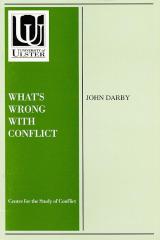|
Centre for the Study of Conflict School of History, Philosophy and Politics, Faculty of Humanities, University of Ulster
What's Wrong With Conflict?
by John Darby
Copies are available in bookshops or, by post, from:Centre for the Study of Conflict University of Ulster COLERAINE Northern Ireland BT52 1SA
T: (01265) 324666 or 324165
What's Wrong With Conflict? by John Darby
Centre for the Study of Conflict
The Centre for the Study of Conflict is a research centre based in the University of Ulster. Its main work is the promotion and encouragement of research on the community conflict and to this end it concentrates on practical issues to do with institutional and community structures and change. It publishes papers and books arising out of this work including: a series of research papers particularly designed to make available research data and reports; a series of Majority-Minority reports; and a series of occasional papers by distinguished academics in the field of conflict. This is a republication of John Darby's paper on conflict. It has been out of print for some time and is still much in demand. It is one of a set of new publications which the Centre will produce over the next few months, on topics such as Education for Mutual Understanding, Peace Education, Sport, Parades, the Role of the Police and Classroom Mediation.
Seamus Dunn Return to publication contents
John Darby is Professor of Ethnic Studies at the University of Ulster. He was one of the founders of the Centre for the Study of Conflict, and was its first Director, a post he held for six years. He resigned in 1991 in order to devote himself to the establishment of the Ethnic Studies Network, and subsequently became the first Director of INCORE, the International Programme on Conflict Resolution and Ethnicity, jointly sponsored by the United Nations University and the University of Ulster. He is a distinguished writer and commentator on a range of issues related to conflict, and on ethnic conflict in particular. He has published a number of books and many papers on the conflict in Ireland, on the dynamics of conflict and on its controls. Return to publication contents
I was concerned that some people might be offended by this title, as it may appear to treat a serious subject frivolously. Despite this, I decided to keep it. Sometimes, to highlight a pertinent issue, it is necessary to ask an impertinent question. The pertinent issue is the need to distinguish between conflict and violence. The tendency to confuse the two terms is not new. It arose around the turn of the last century from the willingness of the new discipline of sociology to regard society rather as a machine that occasionally breaks down, and sociologists as mechanics. Their role was to identify the fault and point out how it might be fixed. It is a view of society which regards conflict as dysfunctional, as evidence that something has gone wrong in the social body. This view of conflict still dominates, especially among American sociologists. But there has been an alternative strain of conflict analysis, weaker but never quite defeated, represented by Georg Simmel almost a century ago and more recently by Lewis Coser. In this view it is as pointless to attack conflict as to attack the ageing process. Conflict is neither good nor bad, but intrinsic in every social relationship from marriage to international diplomacy. Whenever two or more people are gathered, there is conflict or potential conflict. The real issue is not the existence of conflict but how it is handled. Ninety years ago Simmel used a domestic analogy to illustrate the danger of assessing the seriousness of a conflict by its outward expression. He described two married couples, one a model of harmony, considerate towards each other, always in agreement; the other given to spectacular public arguments. Behind these superficialities, however, the real picture may be completely different. The agreement of the first couple may be based on a realisation that their marriage is fragile and threatened; they cannot afford the risk of the one final quarrel which may topple them into divorce. The second couple, on the other hand, confident in the strength of their relationship, can afford to make every disagreement exuberantly public. The same principle, of refusing to take the visible expression of conflict at face value, can be applied to ethnic conflicts. Events in eastern Europe since 1989 are reminders that countries which appeared to be insulated against ethnic conflict were not. Ethnic identity, like the seeds discovered in the Egyptian pyramids, can lie dormant for centuries and, given the right conditions, spring into life. The only solution which history has shown to be completely effective in removing it is genocide. Return to publication contents
| ||||||||||||||||||||||||||||||||||||||||
